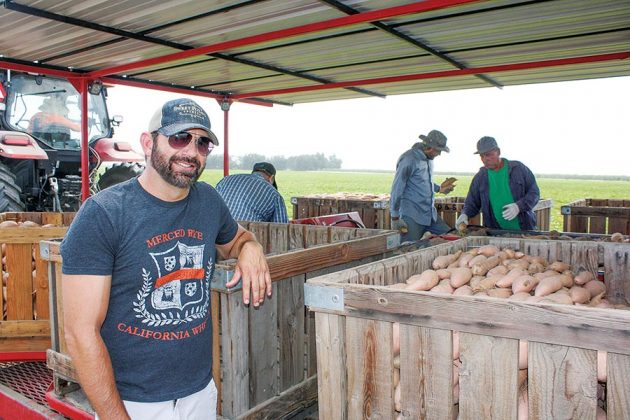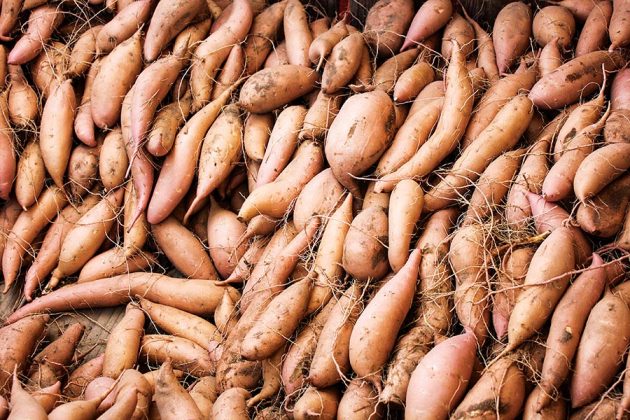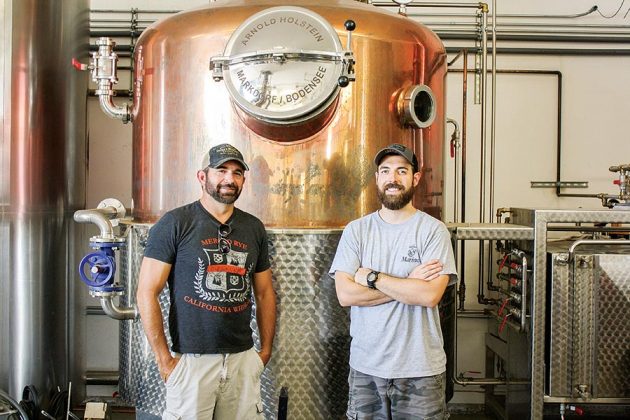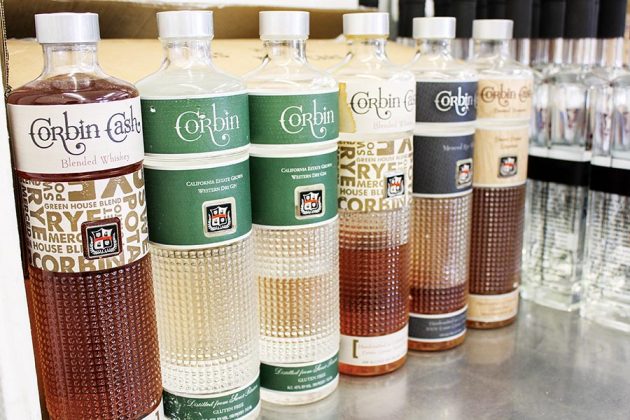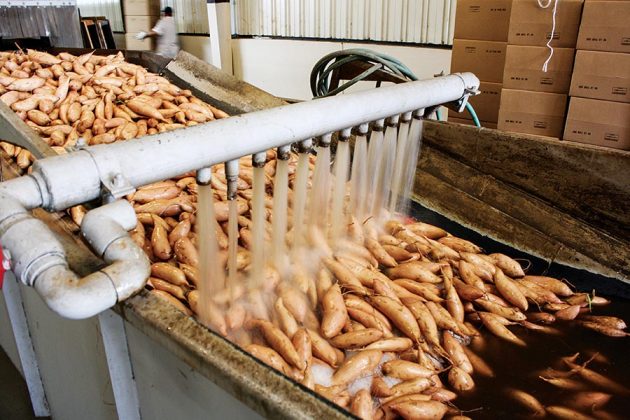If I had to guess, I’d say 42-year-old David Souza III is a gambling man. Not because he dropped out of college to be a successful entrepreneur in the Las Vegas restaurant and club promotions industries, but because one day in 2007 he took a complete 180-degree turn, without any formal training, and decided to open the only craft distillery in Atwater, CA. The kicker is he planned on differentiating his spirits with an ingredient few distillers in their right mind would touch—the sweet potato.
The Start of an Empire
Risk seems to course through the veins of the four generations of Souza men who’ve been farming sweet potatoes in CA’s Central Valley since 1917. During World War I, at 16 years old, Souza’s great-grandfather John emigrated from the Portuguese Azores to Boston with nothing but the shirt on his back, a proficiency for growing sweet potatoes and a whole lot of entrepreneurial gumption. Eventually he made it out West and, with earnings from working in mines near Santa Cruz, CA, bought a small plot of land in Atwater. You could say he literally went back to his tuberous roots.
Three generations later, the Souza family runs an agricultural empire, producing 40 million pounds annually, making them the second-largest sweet potato grower in the state.
“We’re definitely the highest producer as far as bins per acre,” David Souza said with pride while touring a portion of his 2,000 acres on a 106° morning in the middle of the harvest.
His First Big Bet
But sweet potato farming wasn’t always Souza’s master plan. Needing a break from tractors, sorters and the caked-on dust he had to wash off every time he operated an almond tree shaker, he went to Vegas and amassed a network of movers and shakers in the restaurant scene. That’s when the light bulb burst. He devised a plan to sell booze to Sin City. So, he returned home, improvised a still from a copper column and a beer keg, then figured out how to make vodka from the crop he had an endless supply of—sweet potatoes. By then he’d been bitten by the distilling bug and decided to go all-in.
He reached out to consultants for help, but nobody paid him much attention once they heard he was working with sweet potatoes: low in sugar and starch, producing less alcohol and requiring greater time and energy to break down than most other bases. The input costs of sweet potatoes and the commercial-grade enzymes required to break them down are high, and it takes 10–12 lbs., almost twice the amount of regular spuds, to yield one bottle of vodka.
Souza caught his first break when San Jose’s Frank-Lin Distillers recommended he reach out to Lance Winters, master distiller at St. George Spirits, who was generous with his time and knowledge. He also suggested Souza sit through the training seminars hosted by the local Holstein equipment broker.
It took two years to develop the vodka recipe, which was initially named High Roller. It took another 18 months to design and source a bottle covered in diamond pyramids reminiscent of the rubber bumpers you find on the sides of craps tables. Souza tried several vendors in Mexico, but couldn’t get the glass made to his specifications. It was nearly impossible. A year and half later, Souza found an Italian manufacturer for his bottles, which have become the brand’s trade dress. With a name and bottle inspired by rolling dice, he was on the road to producing the perfect Vegas vodka. Or so he thought.
As many others have learned, not every bet you place in Vegas pays off, and by the time Souza returned to Sin City, many of his contacts were gone and he could only get into a few high-end restaurants.
“The real volume in Vegas is in the casinos and clubs,” he said. “On top of that, I was a new father and I wasn’t going to move back to Nevada to hustle and try to make it happen.”
“You don’t have enough money to launch the brand properly and you don’t have a celebrity endorsement to help you sell it,” a representative from Southern Wine & Spirits told him, “so sell your family story.”
Souza dropped the High Roller name and focused on his family story instead, which is why his family’s crest appears on every label. Getting the trademark was another challenge. Souza was too similar to Sauza Tequila, and David is the name of a major sunflower seed producer in the region. So he went with Corbin Cash, his son’s name (inspired by Easton Corbin and Johnny Cash).
The Versatility of a Sweet Potato
In 2012, Souza was the first sweet potato vodka producer in the USA and is now the only producer of sweet potato-based gin, whiskey and liqueur. He manages 100% of the distilling process with assistant distillers Edith Duran and Eric Teague at his side. They process approximately 754,000 pounds of sweet spuds every year through their Bavarian Holstein copper pot stills. They use a 150-liter still for gin and vodka, and for whiskeys a 2,500-liter still, which took 18 months to receive from Germany and upon arrival was three inches too large to fit in the distillery doors. Sweet Potato Spirits produces 200 barrels of spirits, of which they sell 1,800 cases annually.
Souza won’t reveal the recipe to the proprietary blend of varietals that go into Corbin Cash’s vodka and gin, but they’re both made with 100% sweet-potato mash grown on-site, making it a true farm-to-bottle product. A fermented batch of mash takes between six and eight hours to run through the still. For vodka, he redistills 140-proof spirits and rectifies them to 190 proof before chill-filtering and reducing to 80 proof. For their Western Dry Gin, he macerates the 80-proof vodka with a botanical blend of Lisbon lemon, juniper berry, angelica root, coriander and clementine orange and takes that up the short column so it can be diluted to 90 proof.
Gaining in popularity is their barrel-aged liqueur, from a single sweet potato varietal, that’s rectified to 140 proof and watered back to 120 before aging in oak barrels for two to three years. When the spirit is ready, it is infused with cinnamon, vanilla, nutmeg, clove, allspice and 3% brown sugar before it is filtered into the bottling tank and reduced to 35% ABV. He makes a blended whiskey of 20% rye and 80% sweet potato, and his rye whiskey is made from 100% Merced rye, a varietal growing in parts of WA and CA’s Central Valley that his family farm has been using as a cover crop for 100 years.
“Colleagues asked where I bought my rye because there was a shortage in the market. Fortunately for me, we grow tons of it! I just never knew it was worth anything until now,” said Souza.
Some Hurdles Along the Way
Getting to the 10-year mark hasn’t been without its hurdles. Sweet Potato Spirits was the first distillery in the area, so county administrators didn’t know how to proceed with his licensing requests. It wasn’t until they visited the site that they understood craft distilling to be a much smaller operation than they had envisioned.
Once operations were legal, the next challenge was perfecting the process.
“Distilling is distilling,” Souza said, noting the sweet potatoes are washed, ground and cooked for three hours at 200–212° until they become a soup. “There’s not much variation in the process, but the ingredients a distiller uses in their mash and flavoring botanicals is what really sets everyone apart.”
Figuring out the right blend of enzymes and cooking temperatures was tricky. He settled on a three-stage process of adding different enzymes at varying temperatures in their 1,000-gallon cook tank, liquefying starches at higher temps with conversion enzymes. Each step takes about 90 minutes and then the mash goes into 500- and 2,000-gallon fermenting tanks where the yeast feasts for four days if he’s making vodka, and five days for whiskey.
“Figuring out the recipe for the rye was tough,” Souza said. “It kept coming out thick like peanut butter or foaming so much it would burst through the tank gaskets and spray all over the distillery.”
Partnering with a distributor wasn’t easy. Back in 2009, most weren’t interested in working with craft distillers and, “working with a smaller distributor for each region of the country was a logistical nightmare,” he said. “In hindsight, making it is the easy part. Getting rid of it is the challenge.”
But after 10 years of hawking his spirits, the brand has gained traction, and sales are doubling year after year. The distillery is also running more efficiently: What used to take 25 hours to make now takes only five.
Up Next
Souza’s current focus is on using his new California Type-74 Craft Distiller’s license—which allows him to serve cocktails and operate a full-service restaurant—to build a larger 15,000-square-foot distillery and tasting room down the road. The 40-acre property he has his eye on is large enough for a restaurant and concert venue where he can offer both farm and distillery tours.
“It will be a tourism destination for spirit aficionados, and a rest stop for people on their way to Yosemite,” said Souza.
As the Corbin Cash brand grows, the family farm deals with higher demand, the threat of droughts and less consistent weather patterns. The distillery has had little impact on the sweet potato business, other than creating a new revenue stream from the less-valuable, jumbo-size sweet potatoes that typically become frozen french fries or cattle feed.
Looking back, Souza certainly feels like he’s gotten some battle scars, but business is good and getting better. For anyone thinking of getting into the craft-distilling business, he says, “Don’t! But if you must, make sure you do your homework and before you get too deep into it, really prove your product is something people will like.”

